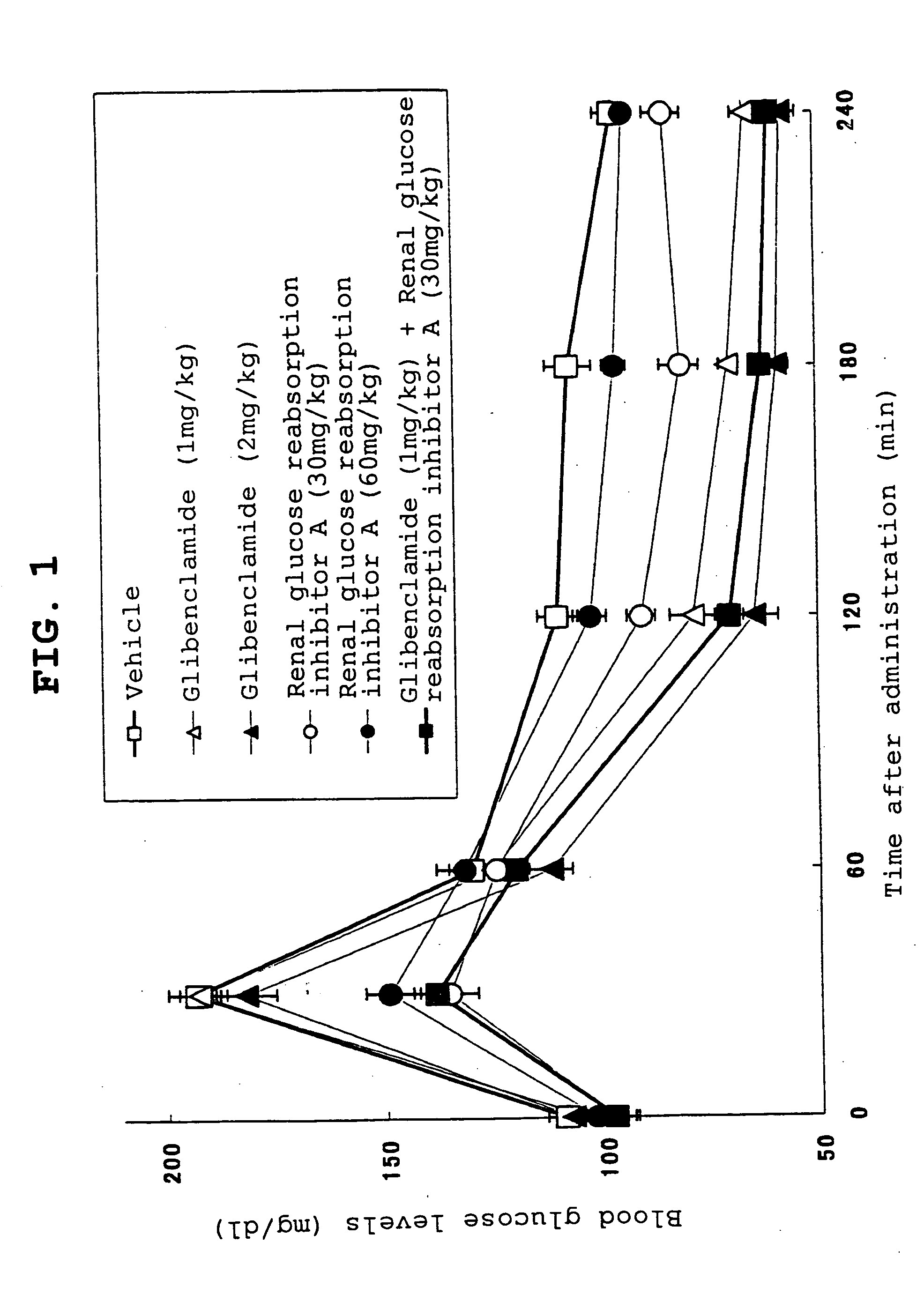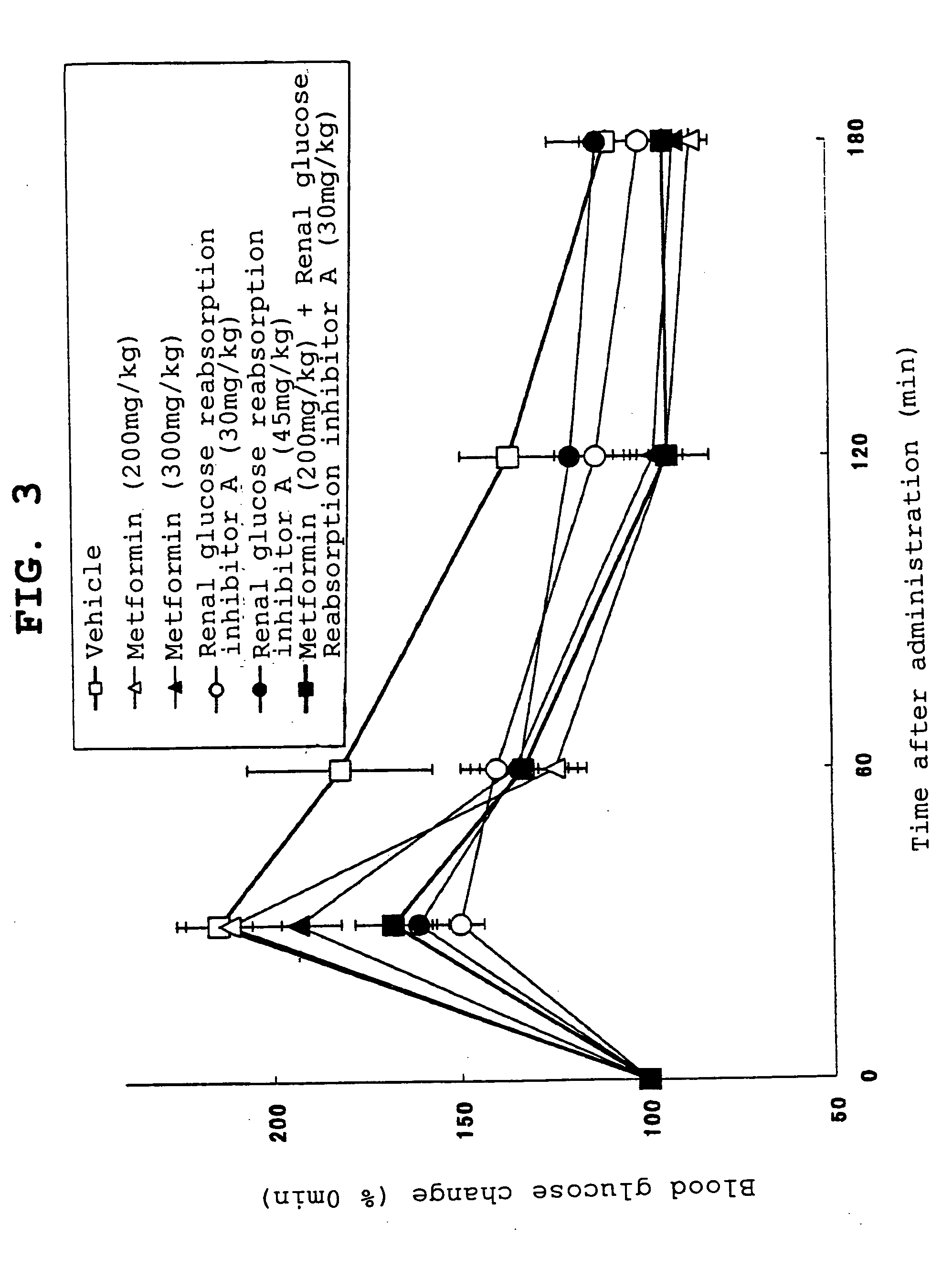Prophylactic and therapeutic agent of diabetes mellitus
- Summary
- Abstract
- Description
- Claims
- Application Information
AI Technical Summary
Benefits of technology
Problems solved by technology
Method used
Image
Examples
example i
[0480] Wistar rats (age of 7 weeks; male) were divided into groups with matched body weights. After 17-hour starvation, glucose was orally given at 1 g / kg to the animals. Immediately after the administration, the inhibitor A of renal glucose reabsorption or the inhibitor B of renal glucose reabsorption (A at 30 mg / kg or 60 mg / kg; B at 30 mg / kg or 80 mg / kg) or glibenclamide (1 mg / kg or 2 mg / kg) or nateglinide (50 mg / kg or 80 mg / kg) was orally given. Additionally, a group on the combined use of both of an inhibitor of renal glucose reabsorption and a hypoglycemic agent was also prepared. A vehicle was orally given to a control group after glucose administration.
[0481] Blood glucose was measured in a time course. As apparently shown in FIG. 1, consequently, glibenclamide (1 mg / kg) did not suppress hyperglycemia immediately after glucose loading (30 minutes), but lowered blood glucose 120 minutes after glucose loading and thereafter, compared with the vehicle group. However, even the i...
example ii
[0483] KK mice (age of 25 weeks; male) fed with a commercially available high-calories feed for breeding (CMF; Oriental Yeast) were divided into groups with matched body weights. After starvation for 17 hours, glucose was orally given at 1 g / kg. Immediately thereafter, the inhibitor A of renal glucose reabsorption (30 mg / kg or 45 mg / kg) or metformin (200 mg / kg or 300 mg / kg) was orally given. Additionally, a group given with the inhibitor A of renal glucose reabsorption (30 mg / kg) and metformin (200 mg / kg) was prepared. A vehicle was orally given to a control group after glucose dosing.
[0484] Blood glucose level was assayed in a time course. As apparently shown in FIG. 3, consequently, metformin (200 mg / kg) dosed did not suppress the increase of blood glucose in the mice 30 minutes after glucose loading but suppressed the increase 60 minutes later and thereafter. The pattern of glycemic suppression did not change even when the dose was elevated (300 mg / kg). The administration of the...
example iii
[0486] Type 2 diabetic model GK rats (age of 7 weeks; male) were divided into groups with matched blood glucose levels and body weights, for once daily oral administration of the inhibitor A of renal glucose reabsorption (30 mg / kg) or glibenclamide at 3 or 6 mg / kg. Further, a group given with a combination of the inhibitor A of renal glucose reabsorption at 30 mg / kg and glibenclamide at 3 mg / kg was prepared. These agents were orally given once daily at the same time period as in the group administered with a single one agent. Only a vehicle was given orally to a control group. On day 25 after the start of administration, blood glucose was assayed sequentially, to compare the groups in terms of the resulting blood glucose levels. The results are shown in FIG. 4.
[0487] As shown in FIG. 4, hyperglycemia was observed in the vehicle-dosed group. In the group given glibenclamide alone (3 mg / kg), however, no difference was observed from the vehicle-dosed group in terms of the blood glucos...
PUM
| Property | Measurement | Unit |
|---|---|---|
| Current | aaaaa | aaaaa |
| Current | aaaaa | aaaaa |
| Current | aaaaa | aaaaa |
Abstract
Description
Claims
Application Information
 Login to View More
Login to View More - R&D
- Intellectual Property
- Life Sciences
- Materials
- Tech Scout
- Unparalleled Data Quality
- Higher Quality Content
- 60% Fewer Hallucinations
Browse by: Latest US Patents, China's latest patents, Technical Efficacy Thesaurus, Application Domain, Technology Topic, Popular Technical Reports.
© 2025 PatSnap. All rights reserved.Legal|Privacy policy|Modern Slavery Act Transparency Statement|Sitemap|About US| Contact US: help@patsnap.com



